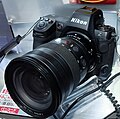 | |
| Overview | |
|---|---|
| Maker | Nikon |
| Type | Full-frame mirrorless interchangeable-lens camera |
| Released | 26 May 2023 |
| Intro price | JPY 599,500 (body only) USD 3,999.95 |
| Lens | |
| Lens mount | Nikon Z-mount |
| Sensor/medium | |
| Sensor type | Stacked back-illuminated CMOS sensor |
| Sensor size | Full frame (35.9 x 23.9 mm) Nikon FX format |
| Sensor maker | Sony Semiconductor Manufacturing Corporation |
| Maximum resolution | 8,256 x 5,504 (45.4 megapixels) |
| Film speed | Native range of ISO 64-25,600 (expandable to 32-102,400) |
| Recording medium | 1 × CFexpress Type B / XQD, 1 × SD (UHS-II) |
| Focusing | |
| Focus | Single-servo AF (AF-S) Continuous-servo AF (AF-C) Full-time AF (AF-F; only available in video mode) Predictive focus tracking Manual focus |
| Focus areas | 493 points (single-point AF) with 90% coverage |
| Focus bracketing | 2-300 frames, step width |
| Exposure/metering | |
| Exposure | TTL metering using camera image sensor |
| Exposure modes | Programmed Auto [P] with flexible program; Shutter-Priority Auto [S]; Aperture Priority Auto [A]; Manual [M] |
| Exposure metering | TTL metering using camera image sensor Highlight-weighted metering: -3 to +17 EV (ISO 100, f/2.0 lens, 20 °C/68 °F) |
| Metering modes | Matrix metering Center-weighted metering Spot metering Highlight-weighted metering |
| Flash | |
| Flash | Built-in: No Hot shoe |
| Flash synchronization | 1/200s (up to 1/8000s using high-speed sync) |
| Flash bracketing | 3 or 5 frames in steps of 1/3, 1/2, 2/3, 1, 1-1/3, 1-1/2, 1-2/3, 2, 2-1/3, 2-1/2, 2-2/3, 3 EV |
| Shutter | |
| Frame rate | Up to 120 fps in 11 MP continuous (C120), up to 60 fps in 19MP continuous (C60), up to 30 fps at full-resolution with JPEG output (C30), up to 20 fps with RAW output |
| Shutter | Electronic shutter |
| Shutter speeds | 900s – 1/32000s |
| Continuous shooting | 20fps / 30 fps / 120fps (expand) |
| Viewfinder | |
| Viewfinder | Quad-VGA (1280x960) EVF (3690000 dots), 0.8x magnification with 50 mm lens, 3000 nits brightness |
| Image processing | |
| Image processor | Expeed 7 |
| White balance | Auto (keep white, keep warm colors, keep overall atmosphere), natural light auto, direct sunlight, cloudy, shade, incandescent, fluorescent (3 types), flash, manual white point (2500K-10000K), preset manual (up to 6 values) |
| WB bracketing | 3 or 5 frames in steps of 1/3, 1/2, 2/3, 1, 1-1/3, 1-1/2, 1-2/3, 2, 2-1/3, 2-1/2, 2-2/3, 3 EV |
| General | |
| Video recording | 8.3K up to 60 fps in 12-bit N-RAW, 8K up to 30 fps with N-log, 4.1K up to 60 fps in 12-bit ProRes RAW HQ, 4K up to 120 fps, 1080p up to 120 fps |
| LCD screen | 3.2-inch vertically and horizontally tilting TFT LCD with 2.1 million dots with touchscreen |
| Battery | EN-EL15c (backwards compatible with EN-EL15a/b batteries) USB-PD rechargeable |
| Optional accessories | MB-N12 battery grip MC-N10 remote grip |
| AV port(s) | Dual USB Type-C, HDMI 2.1 Type-A, 3.5 mm microphone jack, 3.5 mm headphone jack |
| Data port(s) | IEEE 802.11b/g/n/a/ac/Wi-Fi, Bluetooth Low Energy |
| Body features | In-Body Image Stabilization |
| Dimensions | 144×118.5×83 mm (5.67×4.67×3.27 in) |
| Weight | 910 g (32 oz) (with battery) |
| Latest firmware | 3.10 / 17 September 2025 [1] |
| Made in | Thailand |
| Chronology | |
| Predecessor | Nikon D850 |
The Nikon Z8 is a high-end full-frame mirrorless camera produced by Nikon. The camera was announced on May 10, 2023. [2] It is the tenth Z-mount camera body and the seventh full-frame Z-mount body.







